Data Matrix Barcodes: Print Quality and Popularity On The Up
Pharmaceutical Technology Europe
The 2D Data Matrix barcode is a familiar sight for most pharmaceutical manufacturers as printing is implemented to meet certain regulations.
The 2D Data Matrix barcode is a familiar sight for most pharmaceutical manufacturers as printing is implemented ahead of the deadline of 31 December 2010 for pharmaceutical products in France to carry a CIP 13 number in a Data Matrix barcode.1 CIP 13 is the unique number that is allocated to a pharmaceutical product from a range of numbers that are controlled by GS1 France, enabling it to be used throughout the world alongside numbers issued by other GS1 organisations in different countries. Other health agencies in Europe and further afield are also likely to mandate Data Matrix barcodes on pharmaceutical packaging in the future — particularly as the technology has proven that it meets the required demands of coding and traceability in projects, such as the one conducted by the European Federation of Pharmaceutical Industries and Associations (EFPIA).2

Martin Morrison
The information encoded in a Data Matrix barcode is formatted using the structure defined by the GS1 Organisation and detailed in their GS1 General Specifications.3 The standard for data content enables the product to be identified (using the CIP 13 code, in the case of the French market), and also allows additional product attributes to be carried in the same barcode, such as the batch number and expiry date and, if required, unique serial numbers for the item.
These variable data requirements make it necessary to print the barcodes when the product is being packaged; however, this places demands on the printing methods that can be used for the Data Matrix barcodes.
Printing barcodes: points to consider
Recent advances in printing technology, particularly ink jet printing, make printing directly onto the packaging when the product is being packaged perfectly possible, but there are certain potential problems that must be taken into consideration.
Importantly, the structure of the Data Matrix barcode requires the perimeter of the symbol to be well defined because this is where scanners begin when they attempt to decode the data. There is a finder pattern (which is usually square) where two adjacent sides create a shape that looks like an 'L' (Figure 1), and the opposite two adjacent sides consist of alternating dark and light modules. An area of clear space must be left around this finder pattern to enable the scanner to easily locate the Data Matrix barcode. Beyond this clear area (shown grey in Figure 1), text or other graphics may be added as they will not interfere with the barcode scanning.
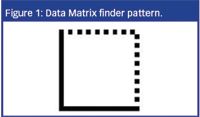
Figure 1
After locating the barcode, a scanner will establish a grid within the boundary defined by the finder pattern. At the location of every crossing point of the grid lines, the scanner will check whether the module is light or dark in colour — every row and column will be checked to establish what data the barcode is carrying. However, not all of the modules in the Data Matrix symbol are used to encode data as a number of the modules will be used as error correction values in case the data does not decode correctly; for example, if an error is identified then the error correction values can be used to determine whether the module should have been dark or light. For a certain number of errors caused by printing defects or damage, error correction routines can be used to still achieve a successful decode, but these can only solve problems in the region inside the finder pattern and cannot make up for damage to the finder pattern itself.
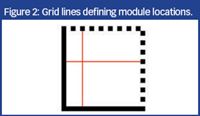
Figure 2
Figure 2 shows that it is easy to draw a pair of grid lines to check a particular location within the bar code; however, if the finder pattern is not well printed it will affect where the grid lines are defined, which may lead to problems with decoding the barcode. It is not vital that the modules are all perfectly square, but the centres of printed modules should be displaced from each other in a consistent manner in both the finder pattern and the data and error correction modules inside the perimeter of the barcode. A Data Matrix barcode carrying product identification, expiry date and batch number will look similar to Figure 3.
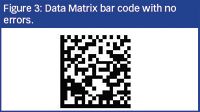
Figure 3
One type of printing error commonly encountered with many printing processes are lines with missing ink, which is usually caused by ink nozzles becoming blocked by dust, dirt or dry ink, and results in a horizontal gap appearing across the barcode (Figure 4). If any of the modules that should have been printed in this row are now missing, they will be identified as errors and will need to be corrected to successfully decode the data.
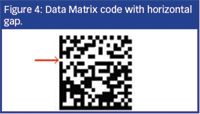
Figure 4
The gap in Figure 4 is exaggerated in its width, but can be seen as a break in the solid vertical line of the finder pattern on the left. It removes a number of modules within the data area of the barcode across the full width of the symbol. The error correction capability of the Data Matrix barcode means this damaged example can still be decoded, but if a second line of missing ink is introduced then the damage exceeds the error correction capacity. Figure 5, with two horizontal gaps, is an example of a barcode that cannot be decoded. The sidebar describes one method that can assess print quality.
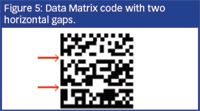
Figure 5
Conclusion
The Data Matrix barcode is just one of many types of 2D barcodes that could be chosen for use on pharmaceutical products. Although some might claim certain technical advantages over the Data Matrix barcode, such as a better tolerance to any peripheral print damage to the barcode, Data Matrix has already become extremely widespread; for instance, many postal services worldwide have adopted Data Matrix, and the technology is also used extensively by the US Department of Defence.
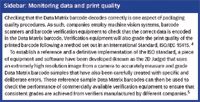
Sidebar: Monitoring data and print quality
There has been a recent growth in the use of Data Matrix barcodes within manufacturing organisations because of the need to identify and trace items within production processes, as well as the wider supply chain. The wide implementation of this coding technology has also driven the development of barcode scanning systems that can improve the decoding performance of Data Matrix barcodes when the print quality is not perfect. For instance, if a Data Matrix barcode has a partially damaged finder pattern, it may still be possible to locate the barcode and attempt to decode it if the rest of the image is intact. It may take longer to try and decode such a damaged barcode, but with processing speeds improving all the time, a scanner might devote more time, having a few more tries with different algorithms before giving up on a particular image.
The printing of Data Matrix barcodes is not particularly challenging for conventional printing methods because the size of the individual modules within the matrix will generally need to be larger than the widths of linear barcodes that are found on grocery packaging, for instance. Controlling or compensating for the amount of ink spread is also less of an issue with Data Matrix unless the ink spread becomes a significant percentage of the module size.
The challenges with printing on pharmaceutical packaging arise with the need to print on the packaging line to encode the expiry date, batch number data and, in due course, serial numbers where these are required. It is also preferable to ensure that the printing of the packaging does not slow down the flow of the line, particularly on fast moving packaging lines. There is therefore a real need for printing technology to further develop to achieve faster printing speeds and yet continue to achieve similar or better print quality in the future. Improvements are already being developed with ink jet systems in the way that the ink is controlled within the nozzle feed mechanisms to help reduce blockages and deliver consistent ink drop sizes to the product. Developments in printing technology will no doubt rise to meet these challenges as the use of Data Matrix barcodes on pharmaceutical products continues to grow.
Martin Morrison is Technical Director at Axicon Auto ID Ltd.
References
1. Club Inter Pharmaceutique www.cipclub.org
2. EFPIA, "Results demonstrate EFPIA anti-counterfeit product verification pilot project successful" (April, 2010). www.efpia.eu
3. GS1 Organisation www.gs1.org
4. ISO/IEC 15415:2004 (International Organization for Standardization, June 2009). www.iso.org
5. B. Moore, Association for Automatic Identification and Mobility (Novermber 2009). www.aimglobal.org
